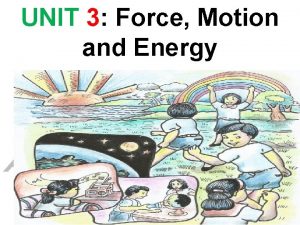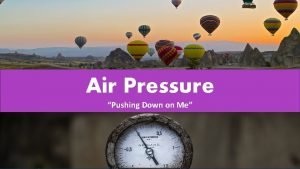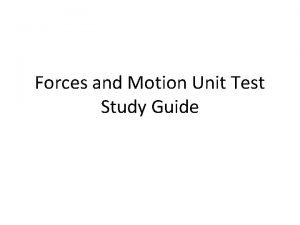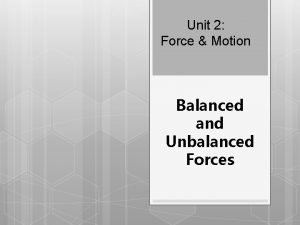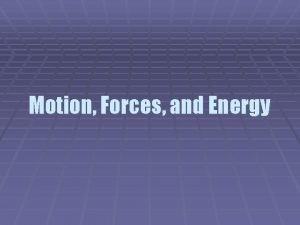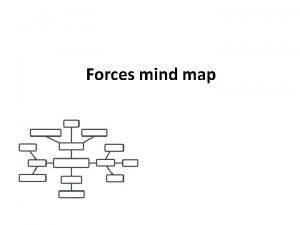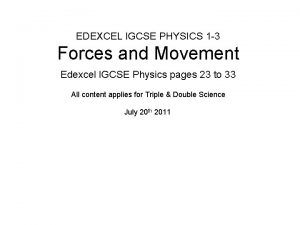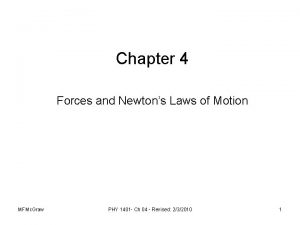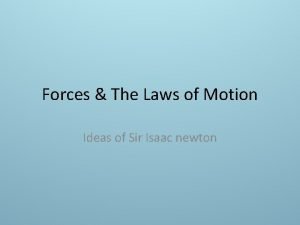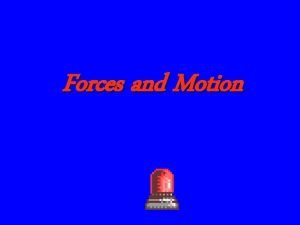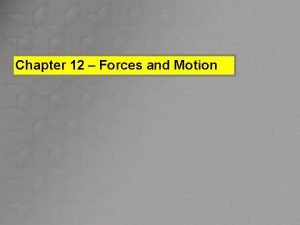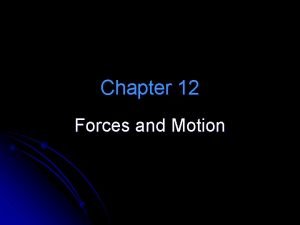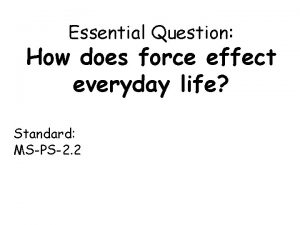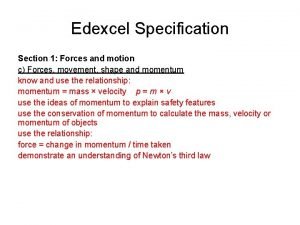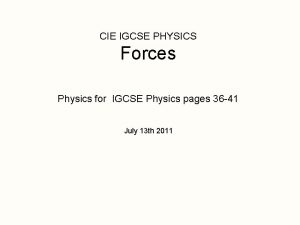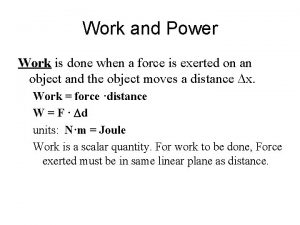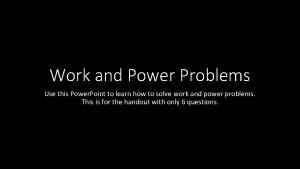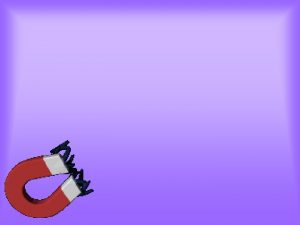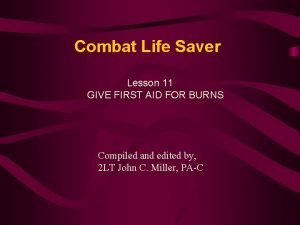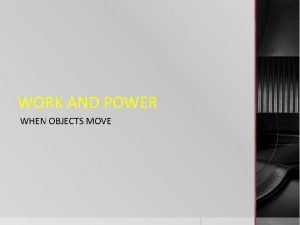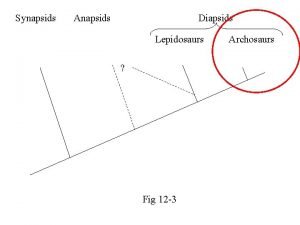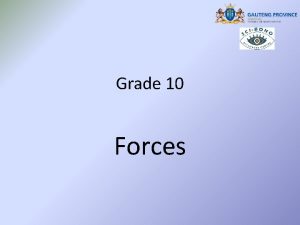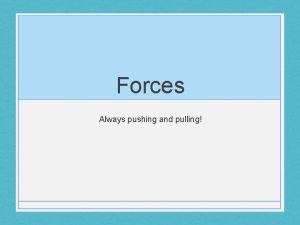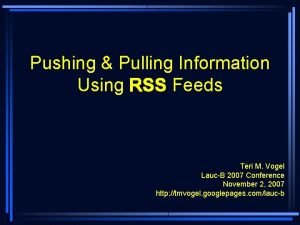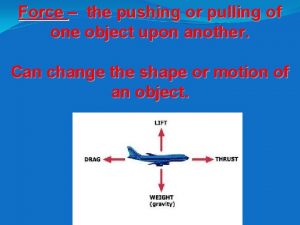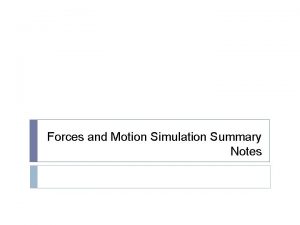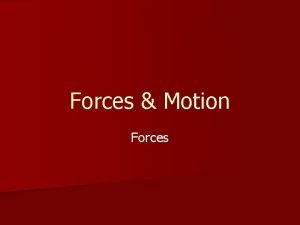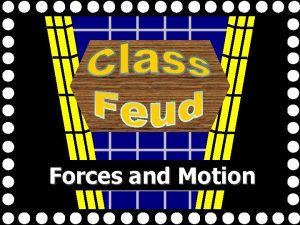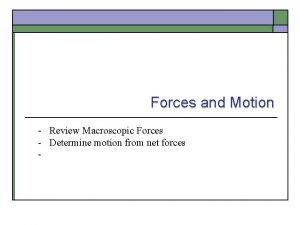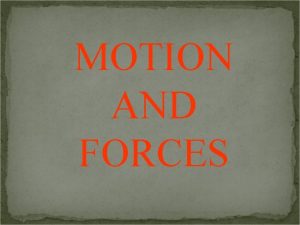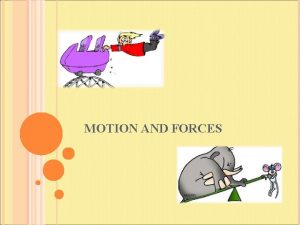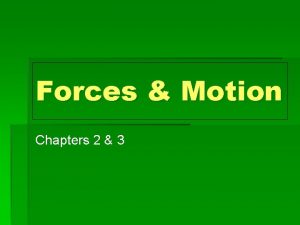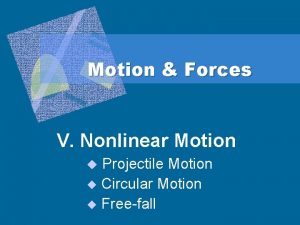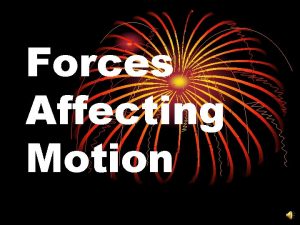Unit 7 Forces and Motion Pushing and Pulling







































- Slides: 39

Unit 7 Forces and Motion

Pushing and Pulling • Learning Goal: I will understand what a force is and what changes it can cause in an object.

Pushing and Pulling • force – a push or pull that causes motion. – forces can: • cause an object at rest to move • cause a moving object to speed up, slow down, change direction, or stop • also change an object’s shape • Forces are measured with a spring scale in units called newtons(N)

Forces Start up Change shape Change direction Speed up Slow down Stop

Pushing and Pulling • Brain Pop: http: //www. brainpop. com/science/motions forcesandtime/force/

Pushing and Pulling 1. Describe the force that the road exerts on the cart on pg. 306. 2. What are some things that a force can do to an object? 3. What do all of these things have in common? 4. Is there any way that an object can move without being pushed or pulled? 5. How can you use a push or a pull to do the same task? 6. Do all forces result in a change in motion of an object? 7. What forces are acting in the picture of the ball hitting the floor, on page 307?

Two Common Forces • Learning Goal: I will be able to compare and contrast the forces of gravity and friction.

Two Common Forces • Gravity - is a force of attraction between two objects. It acts even when objects are not touching. • Gravitational force – all objects in the universe pull on each other. – The more mass the object has the stronger its gravitational force is – The closer objects are to each other the greater their gravitational pull. • In this picture the spring scale with weight attached is being used to measure gravitational force.

Two Common Forces • Brain Pop: http: //www. brainpop. com/science/motions forcesandtime/gravity/

Two Common Forces

Two Common Forces • Friction creates heat. – It changes the energy of motion to thermal energy (heat) as objects rub together. • Your body being dragged across the carpet causes rug burns…Ouch! • Resistance – friction that exist between air and a moving object.

Two Common Forces • Bill Nye : Friction

Two Common Forces 1. What two things determine the force of gravity between two objects? 2. The distance between Earth and the sun is much greater than the distance between Earth and the moon. Why does the sun have a stronger gravitational pull on Earth than the moon does? 3. Why do you put grease on the chain of your bicycle? 4. How can you tell there is friction when you rub your hands together? 5. Classify the role of friction in the following situations as “a helpful force” or “a force to be overcome. ” – A person puts a rubber pad in front of a wet sink to prevent slipping. – Furniture movers place rollers under a piano as the move it from room to room. – A person rubs her hands together to warm them up when they are cold.

Balanced or Unbalanced • Learning Goal: I will understand how to explain the causes and effects of balanced and unbalanced forces on objects.

Balanced or Unbalanced • balanced forces – are forces on an object that are equal in size and opposite in direction. They cancel each other out. • unbalanced forces – when one force is stronger than another and motion changes. – object may start, speed up, slow down, stop, or change its direction A force must overcome the force of friction before an object will move.

Balanced and Unbalanced Forces • Baseball – During a baseball game the batter hits the ball. – When the ball goes soaring away from the batter the forces acting on the ball are unbalanced • Wrestling – When two wrestlers exert force on each other but they don’t move anywhere the forces are balanced.

Balanced or Unbalanced 1. What kinds of forces must act on an object in order for the object to remain at rest? 2. A car pulls away from a stoplight. What kinds of forces are acting on the car? 3. A car moves at a constant velocity down a straight road. What kinds of forces are acting on the car?

Balanced or Unbalanced – Balanced forces MUST act on the same object. • Examples: – the forces acting on you in your desk are an upward force from the chair and a downward force from gravity. – You are between the two forces, both forces are acting on you. • BUT, at the same time, you are exerting a force on the chair and the chair is exerting a equal but opposite force on you. – This is an action-reaction force, not balanced forces because they don’t act on the same object. – There is nothing between you and the chair so there are not two forces acting on either you or the chair.

Balanced or Unbalanced • The arrows represent the forces applied to an object. A longer arrow means a greater force. Which object will move downward. A B C • net force – is the combination of all forces acting on an object. It affects an object’s motion

Balanced or Unbalanced? • To determine Net Force You must look at the plus force and the minus force to determine the net force – Example: • 2 girls are pushing a box to the left. • Each of these girls is exerting 50 N of force on the box • A third girl is pushing the box to the right and is exerting 50 N of force. • The net force on the box is 50 N and the box will move to the left – Example: • 1 boy is pushing a box to the left and is exerting 100 N of force. • Another boy is pushing the same box to the right and is also exerting 100 N of force. • The net force on the box is 0 and the box will not move.

Pull (or Push) Harder! • Large forces can cause objects to change velocity, or accelerate, quickly. (A large force will cause a large change in motion. A small force will cause little change. • Changes in velocity include changes in speed and changes in direction.

Pull (or Push) Harder! • speed – the distance an object travels in a certain time – Speed = distance / time – If two cars of different masses both travel 1 m/sec they have the SAME speed! – If one of those cars accelerates its speed will be greater. • velocity – the distance an object travels in a certain direction in a certain time – if you change speed OR direction your velocity changes – if two cars are traveling at the same speed, in the same direction, then their velocities are equal

Pull (or Push) Harder! • The velocity of a motorcycle rider continues to change during a 1 -minute period. – What can you infer about the motorcycle and the rider?

Pull (or Push) Harder 1. In track and field, one event is called shot put. Competitors throw heavy balls as far as they can. What are two thing that would cause a person to be able to throw a ball farther? 2. Which would cause a greater change in motion – a small fan blowing on a stack of papers or a large fan? 3. What causes the piece of metal to ring the bell in the picture on this page? 4. A man uses a force of 10 N to cause the metal that rings the bell to have an initial acceleration of 5 m/s². How much force would he need to accelerate the metal at 2. 5 m/s² ? 10 m/s²? 20 m/s²? 5. If gravity pulls down on the piece of metal that rings the bell with a force of 10 N, how much force is needed to cause the piece of metal to rise?

I’m Not Moving! • Learning Goal: I will be able to summarize the relationship between the force used to move an object and the mass of that object.

I’m Not Moving! • Acceleration – the rate at which an object’s velocity changes – Acceleration = change in velocity / time – Includes speeding up AND slowing down. – You can use acceleration to determine speed! • Example: a car is stopped at a red light. The light turns green, and the car starts accelerating a 10 km/hr every second. Its speed at the end of 3 seconds = 30 km/hr • 30 km/hr = 10 km/hr x 3 seconds

I’m Not Moving • Brain Pop: http: //www. brainpop. com/science/motions forcesandtime/acceleration/

I’m Not Moving! • If the same force is applied, objects with greater mass accelerate slower than objects with less mass. • How can the steel ball be made to go higher?

I’m Not Moving! • Why does it take the full truck longer to stop than the empty truck?

I’m Not Moving • If an unbalanced force is applied to an object, the object moves in the direction of the force. Draw a graph that shows how the same force will affect objects that have different masses? Increasing motion Increasing mass

I’m Not Moving! 1. What is the relationship between the mass of an object and the force it takes to change its motion? 2. Suppose vehicle A has twice the mass of vehicle B. The drivers step on the brakes, and the brakes apply the same force to each vehicle. What will happen? Why? 3. When Janelle plays tennis, she often hits the ball into the net. She decides that she needs to use a heavier racket to apply more force to the ball so that it will clear the net. Is Janelle’s idea correct? Explain.

Let’s Go to Mars! • Learning Goal: I will be able to explain the steps it takes to overcome forces and send a Rover to Mars.

Let’s Go to Mars! • Unbalanced forces can allow rockets to oppose Earth’s gravity. • Small booster rockets can change the direction of the vehicle’s motion. • Rockets reach an “escape velocity” at which Earth’s gravity will no longer pull the vehicle back down. • Balanced forces allow a spacecraft to move in one direction at a constant velocity through space. • Once the spacecraft reaches Mars, it will accelerate toward the surface because of gravity.

Let’s Go to Mars! 1. In order to send a rocket to the moon or beyond, the engines have to accelerate the rocket to “escape velocity. ” – When the rocket reaches this speed, Earth’s gravity still acts on it, but the rocket is fast enough to leave Earth’s orbit. – What can you infer about the relationship between Earth’s gravity and the velocity of a rocket? 2. How do you know that the forces acting on the rocket before it leaves Earth are balanced? 3. Use forces to explain the purpose of the air bags around the Mars Rover. 4. How can you tell whether the forces are balance or unbalanced?

How Do Forces Affect Motion? • Learning Goal: I will understand how forces of various sizes affect objects of various sizes.

How Do Forces Affect Motion? • Look at the table on page 323, why are there two sections to the table? • What is the value of displaying data in a table such as this? • On the experiment what does pulling the band back farther do?

How Do Forces Affect Motion? • What happens to the distance traveled by the truck as the force increases? • What variable changes in the second part of the investigation? • What happens to the distance traveled by the truck as its mass increases?

What Are Balanced and Unbalanced Forces • Learning Goal: I will understand about the forces that are required to make an object move.

What Are Balanced and Unbalanced Forces • Add a column to the data table to the right of the steps in which you did a trail three times. What do you think you should do with the values you got in these trials? Why? • Suppose that students did the same investigation in several different class rooms. Would their data turn out the same? • What is the value of having many people repeat the same experiment?
 The forces shown above are pushing/pulling forces
The forces shown above are pushing/pulling forces The act of pushing and pulling of a magnet is called
The act of pushing and pulling of a magnet is called Biomechanics of pushing and pulling
Biomechanics of pushing and pulling Pushing down on me
Pushing down on me Energy and forces unit test
Energy and forces unit test Difference between like and unlike forces
Difference between like and unlike forces What are some contact forces and some noncontact forces?
What are some contact forces and some noncontact forces? Unbalanced force
Unbalanced force What are destructive forces
What are destructive forces Intramolecular vs intermolecular
Intramolecular vs intermolecular Intermolecular and intramolecular forces
Intermolecular and intramolecular forces Covalent bond intermolecular forces
Covalent bond intermolecular forces Unbalanced force
Unbalanced force Motion forces and energy
Motion forces and energy Graphic organizer or mind map about intermolecular forces
Graphic organizer or mind map about intermolecular forces Igcse physics forces and motion
Igcse physics forces and motion Force and motion summary
Force and motion summary Chapter 11 section 3 motion and force answer key
Chapter 11 section 3 motion and force answer key Derek leaves his physics book on top of a drafting table
Derek leaves his physics book on top of a drafting table Newton's laws jeopardy
Newton's laws jeopardy Laws of motion
Laws of motion Chapter 12 forces and motion
Chapter 12 forces and motion Motion forces and energy
Motion forces and energy Study jams forces and motion
Study jams forces and motion Is momentum a force
Is momentum a force Terminal velocity igcse physics
Terminal velocity igcse physics Balanced and unbalanced forces
Balanced and unbalanced forces Work vs power
Work vs power Hans full is pulling on a rope to drag
Hans full is pulling on a rope to drag Oblique pulling spinal manipulation
Oblique pulling spinal manipulation Static postural assessment
Static postural assessment Why is magnetism an invisible force
Why is magnetism an invisible force Pulling down the wall of jericho
Pulling down the wall of jericho Split ring heat exchanger
Split ring heat exchanger Lesson 11 wire-pulling techniques
Lesson 11 wire-pulling techniques A 45-kg merry-go-round worker
A 45-kg merry-go-round worker Proton pulling power
Proton pulling power Renatta gas is out with her friends
Renatta gas is out with her friends Proton pulling power
Proton pulling power Ornithischian
Ornithischian

